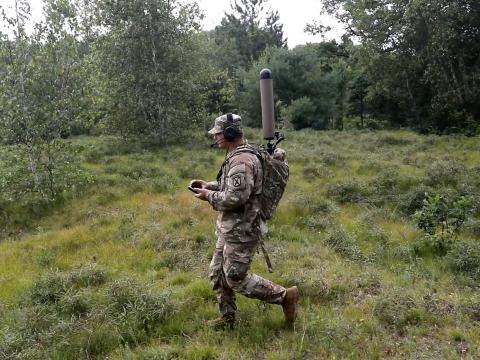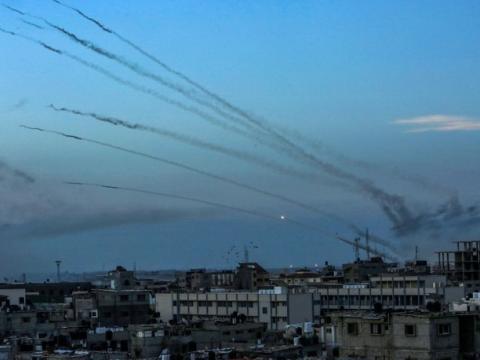Improvised Explosive Devices A Multifaceted Threat
 |
| A car bomb explodes in Iraq. The battle against improvised explosive devices (IEDs) is fought on a shifting technological landscape as terrorists continuously change their ways to try to stay a step ahead of allied countermeasures. |
The fight against improvised explosive devices has shifted focus. In the early days of the Iraq War allied forces sought primarily to protect themselves from the blasts. Today, however, the counter-device effort now ranges from preventing detonation to breaking up terrorist networks that are responsible for the deployment and use of explosive weapons.
Communications are playing a significant role in helping defeat improvised explosive devices (IEDs). For all aspects of the counter-IED effort, allied forces rely on communications among themselves and with leading IED experts in the
The use of IEDs did not begin with the Iraq War. Improvised explosive devices have been used in warfare since the invention of explosives. Terrorism campaigns throughout history have relied on IEDs, and the Global War on Terrorism began with two IEDs flown into the
Dr. Robert L. Keesee, deputy director of the Joint IED Defeat Organization, or JIEDDO, likens the battle against IEDs to countermeasures against any other military weapon. “Solving IEDs in some ways will be as difficult as solving the problem of bullets,” he analogizes. “Bullets have been in use for centuries, and we still have not completely solved that [weapon] as a wartime threat.”
He explains that the long-term task facing his organization is to counter IEDs as a strategic influence. Rendering their strategic influence null would reduce their use to tactical effect only. Many of the primary efforts underway today aim largely at stopping IEDs at that tactical level.
Counter-IED work takes place on several fronts. These efforts largely focus on mitigating the effects of the devices, preventing their use or stopping the groups that use them. When JIEDDO was established more than two years ago, almost 80 percent of its funds went into mitigation or prevention. But even then, officials realized that mitigation and prevention were not long-term solutions. The key lay in stopping the insurgent groups before they could employ IEDs, and JIEDDO’s emphasis has shifted to a greater reliance on disrupting terrorist networks and training allied forces. Now, only about half of JIEDDO’s funds go into mitigation or prevention.
Being able to mitigate the effects of IEDs largely has entailed improving armor. Efforts have focused on increasing the protection afforded military vehicles as well as better discipline in the use of personal protective equipment. To prevent IED use, experts have worked to jam signals for radio-controlled IEDs.
Stopping the groups that use IEDs is a much higher level task. Keesee reports that as many as 160 main groups in
“When we think of a threat, our English deceives us,” Keesee explains. “It’s really threats—many, many threats; and like street gangs, they are highly adaptive.”
For example, one of these street gangs may deploy an IED one day, view how it works and act on how well the device performed—either using it to a greater degree or changing its design. They might choose to keep it to themselves, or they might share it with others. That sharing might take the form of direct contact through a network of relatives or open-source presentation through a blog or other Web site.
Similarly, a hierarchical group might share effective IED technology through its hierarchy. How the IED threat adapts to
The smaller groups may import technologies from the hierarchical structure, and some leavening of those technologies takes place because they need to be used at the street-gang level, Keesee states. Some of these imported technologies come from outside Iraq or Afghanistan—a point emphasized by Gen. David H. Petraeus, USA, commander, Multinational Force in Iraq, in recent congressional testimony that charged Iran with supporting Iraqi terrorists.
Keesee relates that JIEDDO refers to this fight against the groups that wield IEDs as “attacking the network.” With 160 groups of IED users in
 |
| An underbelly IED is found encased in concrete so that it can be set off when a target vehicle passes above it. As allied countermeasures became more effective, roadside and vehicle underbelly IEDs were supplanted by vehicle-born IEDs and suicide bombs. However, different terrorist groups still will employ them when convenient. |
This effort to attack the networks and make it harder for adversaries to carry out IED attacks has changed the nature of their use, Keesee continues. IEDs now tend to be deployed less carefully and less effectively. “They’re easier to detect, they’re easier to find, so they’re easier to defeat,” he declares.
But that does not mean that the IED battle is won with each defeat of a device. One of the biggest challenges that JIEDDO continues to face is the resurgence of various types of IEDs. Keesee relates how IEDs that JIEDDO thought it had defeated a couple of years ago always seem to re-emerge. The multitude of threats is the reason for that IED redundancy, he explains. In some cases, terrorists who are working out of a single garage workshop may opt to try an old design that they either abandoned completely or shelved in favor of another approach. In either case, allied forces find themselves dealing with an old threat with the same degree of lethality.
“Everything that we may have encountered in the past is probably an ongoing threat to some degree,” Keesee says. “It may be a greater threat tomorrow. “For example, we have seen no RF [radio frequency] threats that are no longer used.
“Everything is still in play.”
Keesee goes on to note that many of the RF devices used to trigger IEDs are coming from retail consumer electronics as well as from industrial electronics. JIEDDO officials have seen elements that are found in industrial controls. These might include telemetry systems similar to those used as utility meters, which can employ inexpensive RF devices to report current usage. The industrial control RF devices, while mass produced, are not as easily adapted at the garage workshop level, so their use is more likely to be found among hierarchical terrorist groups.
One tactical trend that has been observed is a greater diversity of IED triggers, Keesee allows. After relying extensively on conventional RF triggers, terrorists now are employing more diverse RF triggers as well as land wire and pressure devices. The trigger capability also has improved from simple detonation to an arming and detonating system. In some cases, these sequential actions are performed by two different technologies.
Delivery methods continue to vary. Roadside and vehicle underbelly IEDs have been supplemented by vehicle-born IEDs and suicide bombs. Many suicide bombers are not volunteers but instead are tricked or coerced into serving as IED delivery systems, and their bombs are set off remotely.
“They take a measure, we take some effort to counter it, and then they counter that countermeasure, and so it goes,” Keesee relates. “Almost none of the measures that they have used have gone into disuse.”
To counter this adaptive threat at the strategic level, JIEDDO has needed to bring “new time constants” to existing institutions, Keesee reports. The acquisition and training communities, for example, had been accustomed to working with timelines of years and program objective memorandum cycles. IED threats require working with time frames of weeks, Keesee notes, and JIEDDO has had “significant success” building new ways of acquiring vital gear and implementing new ways of training soldiers and Marines.
Keesee states that a cornerstone of success against IEDs has been communications. In particular, feedback loops in theater have provided JIEDDO with vital information that can be applied to the counter-IED effort. JIEDDO task forces Paladin and
Training entails teaching warfighters how to find IEDs, use RF countermeasures and collect information that will help allied forces disrupt networks. Individual soldiers and Marines are taught to seek information about the terrorists groups and their networks. Small unit leaders are taught to integrate and fuse that information, while larger command staffs are taught how to fuse that product with information from outside the unit. Keesee explains that this training is taking place at all levels and occurs increasingly at home stations and at major readiness exercise sites.
The organization is spending significantly more on training and attacking networks than it did in its early days, Keesee notes. When the organization was established, it had to focus on effect mitigation because that was the overarching priority. Now that JIEDDO has gotten the upper hand over some aspects of mitigation, it is looking to move up the event chain to focus on prevention.
JIEDDO seeks to shorten timelines further, he adds. From the time of a favorable response to a concept, the organization wants to be able to move a materiel initiative through the decision process to funding for fielding within 45 days. As fast as that would be, it would not be fast enough for some threats, he cautions, so the JIEDDO will need to refine its feedback loops.
One issue for disrupting the networks is connected to
However, that has its own drawback. It is not unusual now to see Iraqis using cell phones while walking down city streets, but one of those cell phone users may be planning or implementing an IED attack. Differentiating between the two is difficult. This is where disrupting the terrorist network plays a big role.
Disrupting those cell phone calls also is causing a problem. For the time being, successful IED jamming also can affect civilian and allied communications. Over the long term, JIEDDO’s ideal IED jamming system would allow warfighters to employ their full range of communications while jamming terrorist threat devices. Keesee offers that JIEDDO is moving increasingly toward that goal.
JIEDDO is working with the service and national laboratories, often in partnership with industry, to develop solutions to the IED challenge. One key effort aims at identifying RF devices, metallic substances or volatile materials where they should not be sited. Keesee emphasizes that industry and the laboratories should work with JIEDDO closely to ensure they understand the challenge and focus their efforts correctly.
“The threats will be adaptive until they are given to understand that we can defeat their devices as a strategic influence,” he declares. He adds that JIEDDO needs industry’s support and talent in helping understand the problem to bring creative solutions.
When it was formed, JIEDDO pursued virtually every solution that had a possibility of working, and it funded every nonduplicative concept that had some counter-IED potential, Keesee relates. Since then, the organization has solved many of the easy problems. The challenge now is for JIEDDO to become more deliberate about threat themes, he says.
Keesee warns of one pitfall that could derail counter-IED efforts. The potential exists for
And the enemy is doing the same thing. “They are spending tremendous amounts of time observing, watching how we behave tactically, looking for the strengths and weaknesses in our materiel systems, figuring out how they can take relatively simple means and attack those weaknesses,” Keesee warns. “They are spending 99 percent of their time observing us. We should learn from that and spend an equal amount of time understanding the problem space before proposing technical solutions.”
That problem is not likely to go away with the end of
Web Resource
JIEDDO: https://www.jieddo.dod.mil


Comments